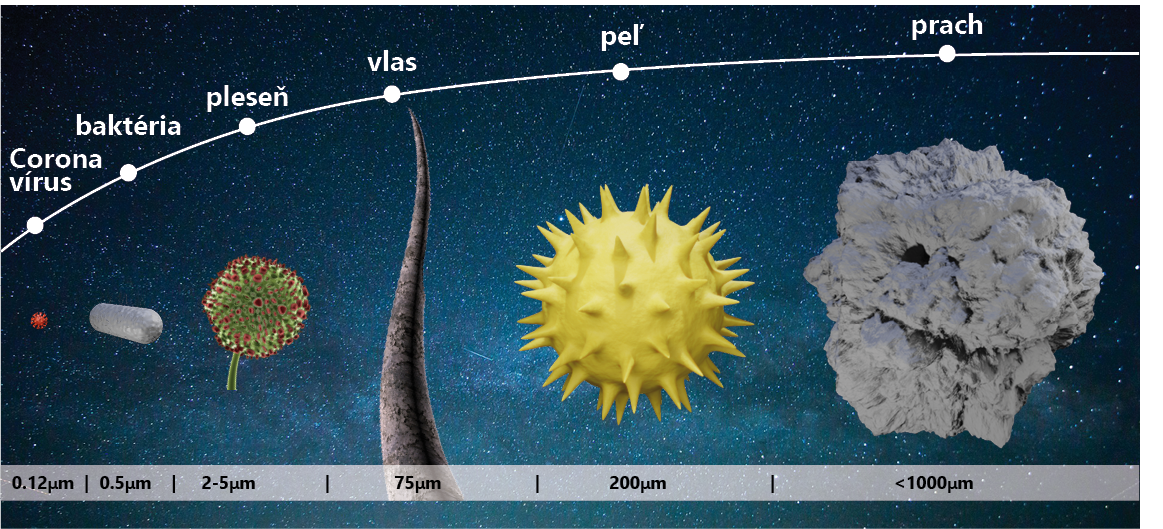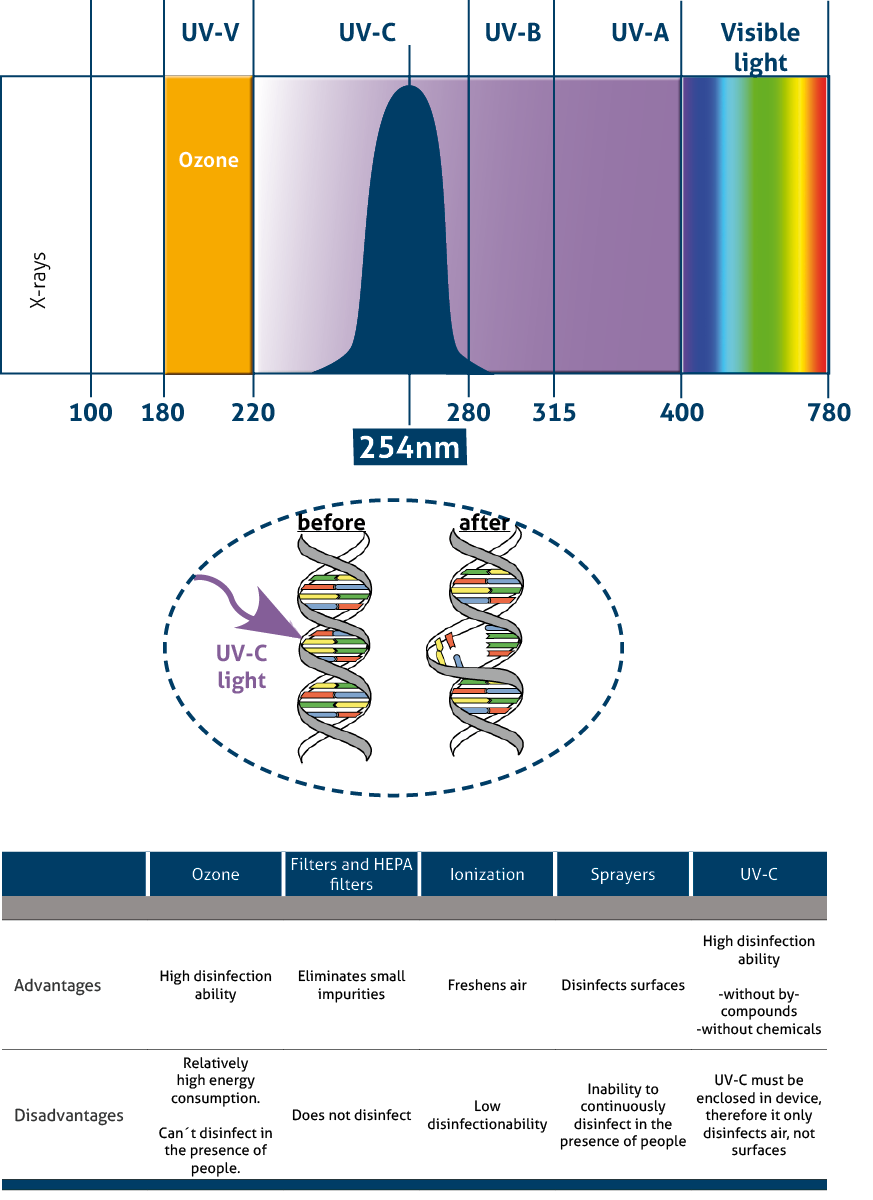How to disinfect and clean the air?
This has been probably the most relevant question since 2020 throughout almost the whole planet. Google is reporting an enourmous rise in usage of search words like „cleaner“, „germicidal“, „disinfection“...
Indeed, many of us are looking for ways to reduce the potential risk of an infection for our loved ones, for our businesses or companies. We are looking for protective equipment, disinfectant gels and devices that clean or disinfect air, objects and people. In this article, I will show you to the "world" of air cleaning and disinfection.
There are several levels of air cleaning. We clean it from visible, barely visible and from microscopic impurities. We clean due to dust, allergens or, very actual this year, we are disinfecting against viruses and bacteria. And the size really matters.
For example, a grain of dirt or dust may be 0.01-1mm in size. Pollen can be 15 to 200 µm (200 millionths of a meter or 0.2mm). The size of viruses and bacteria is already indicated in nanometers (nm), i.e. in billionths of a meter or 0.000001 mm. For example the Corona virus has an average size of 120nm (0.12 µm).

While writing this blog, I came across a study from March 20, 2020 (Setti et all), which was published in the Italian Society for Environmental Medicine (SIMA). The study focused on the spread of Covid-19 with particles above 50µm in Italy. The study confirmed that there is dependence between polluted air and Covid-19 spread rate. / source https://abcdust.net/how-large-is-a-coronavirus-virion-compared-to-the-mp10-2-5/ Admin 28.04.2020 /. This study confirmed the already known fact that viruses and bacteria, although small in size, "travel" on larger particles. The incidence of viral infections thus correlates with levels of particles in the air. (Ciencewicki J. et al., 2007; Sedlmaier N. et al., 2009). Experience in Italy thus really shows a straightforward relationship between occurrence of larger solid particles (impurities) and Covid-19. Therefore, it is also necessary to mechanically clean the air.
What is used to clean / disinfect air?
- Ozone
- Filters and HEPA filters
- Ionizers
- Sprays with disinfection liquid
- UV-C
Coarse mechanical impurities greater than 10 µm such as dust, pollen, etc. are captured on the pre-filter, for example class G3 (according to EN779 and EN1822). Smaller particles are captured on the HEPA filter (> 0.3 µm). However, microscopic particles, due to their miniature dimensions, cannot be captured, so we have ways to kill them.
The HEPA filter itself only traps particles. Depending on the specific type of filter, smaller particles than its "capture network" will physically "pass" through it. Commonly available HEPA filters catch anything larger than 0.3µm particles. H11 (capture rate <95%) and H13 (<99.95%) are also 2 common classes. However, the HEPA filter does not have the ability to disinfect or kill viruses or bacteria. It is purely a mechanical barrier. Therefore, if you have found an "excellent" air purifier based only on the HEPA filter, consider whether this will brings you the desired effect.
Ionizers are better known as air fresheners. Ionization-based purifiers charge particles present in the air (aerosoles - particles with a size of 6-12µm), whereby these are mutually "attracted" by opposite polarity or repel the same polarity. This way, the particles are either agglomerated or trapped on room surfaces, floors, tables, etc. Ionizers are used to disinfect against bacteria and eliminate fungi. However, the number of negative ions (anions) decreases significantly as you move away from the device. For example, within half a meter of the device, the device may produce 400,000 (four hundred thousand) anions per cm3, but at a distance of 2.5 meters it is only 300 (three hundred) anions per cm3. Ionizers can pleasantly refresh the air, but their use for reliable and especially fast (effective) air disinfection is insufficient. But they can be used in the presence of people. However, beware of poor quality ionizers! These emit more ozone and can be dangerous for you.
Liquid spraying is used to disinfect surfaces rather than rooms. We can see them, for example, when disinfecting trains, cars or cleaning various areas (entrance halls, etc.). Their disadvantage is that they disinfect with an agent which is sprayed to create aerosol which is essentially water vapor. You will not continuously spray on yourself, or on your customers or employees. It's not just practical. Therefore, spray disinfection is done once and is not suitable for continuous cleaning.
UV-C-based air disinfection is commonly used. Technically, this process is called photolytic oxidation (after the addition of the catalyst also photocatalytic oxidation). UV-C radiation is one of the "UV" spectra. You will definitely know UV-A and UV-B. In the summer, you probably buy sunscreens to block this radiation, thus protecting your skin and by wearing sunglasses your eyes. UV-C has the ability to disrupt the DNA of viruses or bacteria. After exposure of a particular microorganism to UV-C, it undergoes photochemical decay of its DNA, this way it dies. Although ozone has higher oxidation (disinfection) ability than UV-C, the advantages of using UV-C clearly puts this method of disinfection to first place.
Just like UV-A and UV-B are dangerous in certain doses, also UV-C can be harmful to eyes and skin when exposed directly. Therefore it is only possible to disinfect air with UV-C in the presence of people with a closed (sealed) air cleaner. Such a device draws in air, "transports" it around a UV-C radiation tube, which disrupts the DNA of the microorganisms present and ideally everything else is still caught by a HEPA filter. This way the device outputs clean, healthy air. Of course, this depends on the extent of air contamination, to what extent is the device able to blow clean air immediately.
The UV-C light inside any germicidal device must be of good quality. By "quality" is meant the wavelength of the emitted UV-C spectrum. If the tubes are of good quality, they will radiate at a wavelength of 253.7nm (or 254nm). A quality UV-C tube does not generate ozone. Therefore, UV-C devices are ozone-free. Ozone is formed at a wavelength of 180-220 nm. Quality devices have the necessary certificates and especially quality components. In this respect, it is not reasonable to save or look for a cheap solution, as this can completely miss the effect and, conversely, can cause undesirable outcomes.

Last but not least, the nominal power of the UV-C tubes in the germicidal device itself is very important. Various "home" air purifiers are available on the market; they look beautiful, flashing and shining beautifully. However, if we look at their technical specification, we find that they use UV-C tubes of a dubious 8W power supply. It's like cooking a Sunday lunch on a small piece of wood.
Virus destruction is a function of UV-C dose and time. Hence, with how much power and for how long do you irradiate the virus. The higher the dose and the longer the time, the more viruses you will kill. Of course, we are talking about a device that is designed to be disinfecting in the presence of people and therefore cannot have gigantic dimensions with noisy operation. We need something strong enough and quiet at the same time. That's why we applied higher dose of UV-C (90W) and a specially designed disinfection chamber with air retardants. The dose of 90W is one of the largest, far exceeding small household cleaners (with only 8W) and also this dose exceeds conventional hospital or medical UV-C emitters (30-60W).
We used Karman air swirlers in our disinfection chamber causing multiple vortex areas. If the air is swirled, it "stays" in the chamber longer than air that flows directly through the chamber. This way the time and dose of UV-C increases, which boosts the targeted killing of microorganisms.
We combined of above, in a compact design that fits perfectly into any space. In addition, the Athmoss is equipped with a G3 class pre-filter and a HEPA filter to capture the smallest particles. In this combination, the Athmoss air disinfector is unique.
The biggest advantage is the possibility of constant air disinfection in the presence of people. Athmoss does not emit any UV-C light outside of its construction, so it is completely safe and suitable for air purification in full operation in the presence of people. This is the main purpose of this product.
Maybe you already have an air purifier, maybe you weren't happy or you're looking for something new. We have created a unique device that will not cure you, but will reliably protect you. With the development of Athmoss, we have aimed at means of reducing the risk of transmitting infections to a minimum in facilities where people are located, work, dressing rooms, ... in short, they function. We wanted a device that sucks air from the room into itself, reliably removes the microorganisms present in it and pushes the harmless air back out.Thank you for your time, I believe that this blog was beneficial for you. I wish you a lot of patience and good health in these difficult times.
Head of Export department

